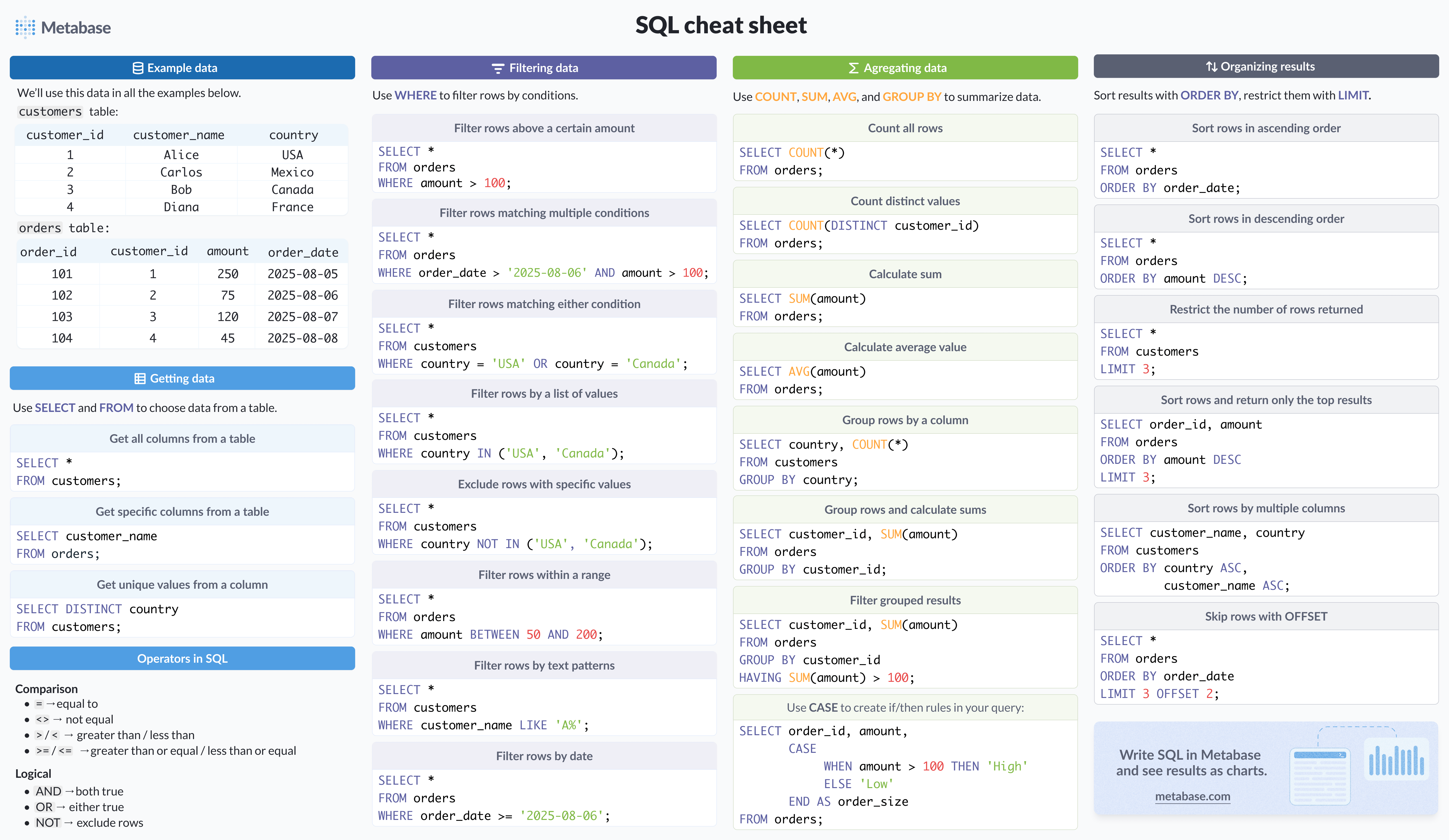SQL cheat sheet
Get our SQL cheat sheet for beginners with how to filter and aggregate data, examples, best practices, and more.

SQL Cheat Sheet for Beginners
Learn SQL with this beginner-friendly SQL cheat sheet. Whether you’re exploring data in Metabase, practicing SQL queries, or brushing up on the basics, this cheat sheet gives you all the essential SQL commands.
For the data team, it’s a great resource to share with business users so they realize SQL is just asking the database questions and start pulling their own data without waiting for your team.
Example Data
We’ll use two tables throughout this cheat sheet.
customers
| customer_id | customer_name | country |
|---|---|---|
| 1 | Alice | USA |
| 2 | Carlos | Mexico |
| 3 | Bob | Canada |
| 4 | Diana | France |
orders
| order_id | customer_id | amount | order_date |
|---|---|---|---|
| 101 | 1 | 250 | 2025-08-05 |
| 102 | 2 | 75 | 2025-08-06 |
| 103 | 3 | 120 | 2025-08-07 |
| 104 | 4 | 45 | 2025-08-08 |
Getting data
Use SELECT and FROM to choose data from a table.
Get all columns from a table
SELECT *
FROM customers;
Get specific columns
SELECT customer_name
FROM orders;
Get unique values from a column
SELECT DISTINCT country
FROM customers;
Filtering data
Use WHERE to filter rows by conditions.
Filter rows above a certain amount
SELECT *
FROM orders
WHERE amount > 100;
Filter rows matching multiple conditions
SELECT *
FROM orders
WHERE order_date > '2025-08-06'
AND amount > 100;
Filter rows matching either condition
SELECT *
FROM customers
WHERE country = 'USA'
OR country = 'Canada';
Filter rows by a list of values
SELECT *
FROM customers
WHERE country IN ('USA', 'Canada');
Exclude rows with specific values
SELECT *
FROM customers
WHERE country NOT IN ('USA', 'Canada');
Filter rows within a range
SELECT *
FROM orders
WHERE amount BETWEEN 50 AND 200;
Filter rows by text patterns
SELECT *
FROM customers
WHERE customer_name LIKE 'A%';
Filter rows by date
SELECT *
FROM orders
WHERE order_date >= '2025-08-06';
Aggregating data
Use COUNT, SUM, AVG, and GROUP BY to summarize data.
Count all rows
SELECT COUNT(*)
FROM orders;
Count distinct values
SELECT COUNT(DISTINCT customer_id)
FROM orders;
Calculate sum
SELECT SUM(amount)
FROM orders;
Calculate average value
SELECT AVG(amount)
FROM orders;
Group rows by a column
SELECT country, COUNT(*)
FROM customers
GROUP BY country;
Group rows and calculate sums
SELECT customer_id, SUM(amount)
FROM orders
GROUP BY customer_id;
Filter grouped results
SELECT customer_id, SUM(amount)
FROM orders
GROUP BY customer_id
HAVING SUM(amount) > 100;
Use CASE for conditional logic
SELECT order_id, amount,
CASE
WHEN amount > 100 THEN 'High'
ELSE 'Low'
END AS order_size
FROM orders;
Organizing Results
Sort results with ORDER BY, restrict them with LIMIT.
Sort rows in ascending order
SELECT *
FROM orders
ORDER BY order_date;
Sort rows in descending order
SELECT *
FROM orders
ORDER BY amount DESC;
Restrict the number of rows returned
SELECT *
FROM customers
LIMIT 3;
Sort and return only the top results
SELECT order_id, amount
FROM orders
ORDER BY amount DESC
LIMIT 3;
Sort rows by multiple columns
SELECT customer_name, country
FROM customers
ORDER BY country ASC, customer_name ASC;
Skip rows with OFFSET
SELECT *
FROM orders
ORDER BY order_date
LIMIT 3 OFFSET 2;
More SQL resources
This cheat sheet is a great way to dip your toes into SQL, but once you’re comfortable with the basics, you may want to explore more advanced techniques and dive deeper into data analysis. We’ve got you covered there with our Learn SQL path, which includes articles like:
- SQL filtering by text
- SQL filtering by date
- Combining tables with SQL UNION
- Best practices for writing SQL queries
- Debugging SQL syntax errors
- And much more: Learn SQL

